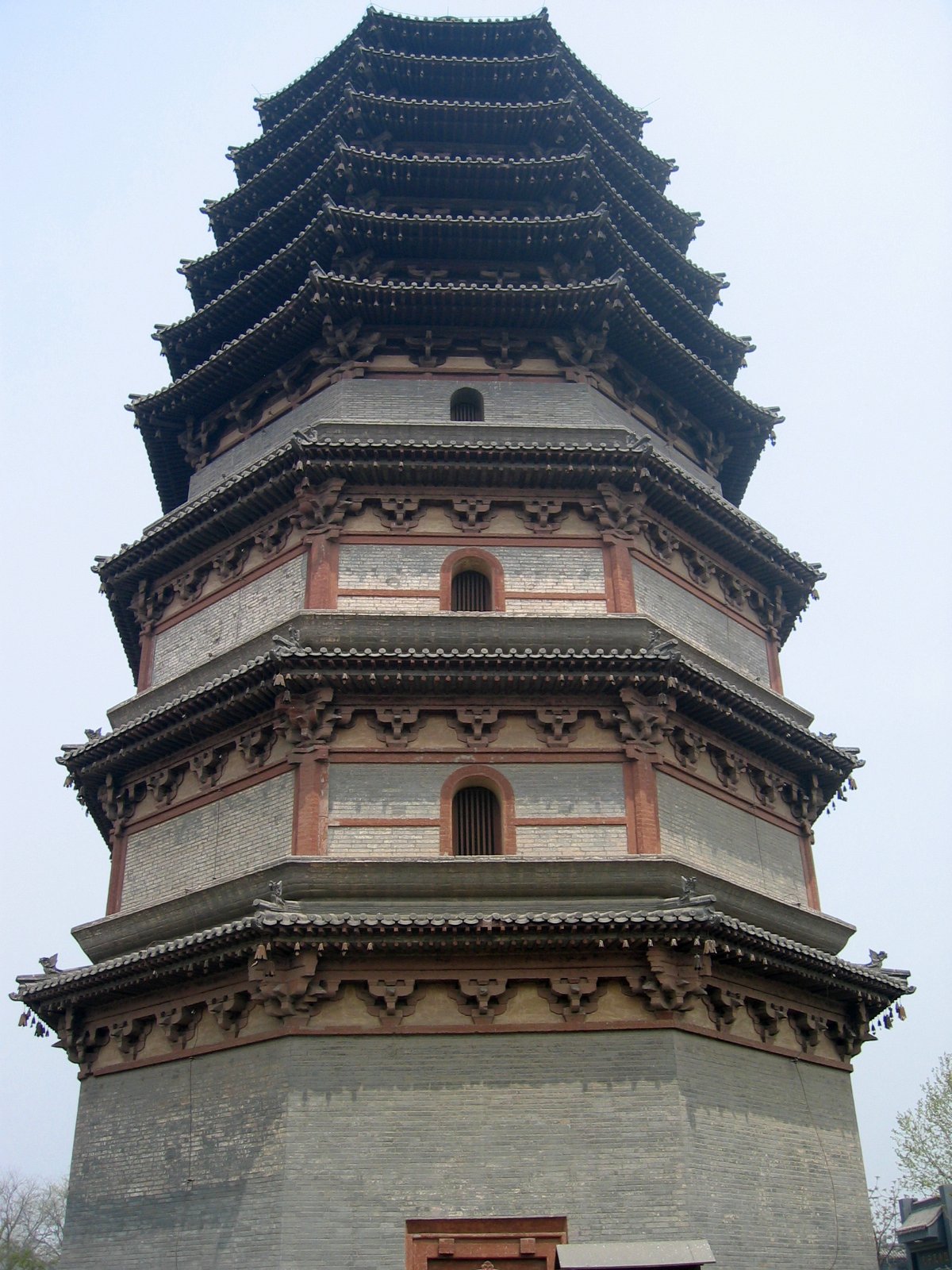Lingxiao Pagoda on:
[Wikipedia]
[Google]
[Amazon]

 The Lingxiao Pagoda () is a
The Lingxiao Pagoda () is a
Lingxiao Pagoda at Chinaculture.org
{{coord missing, Hebei Buddhist buildings in Shijiazhuang Stupas in Hebei Pagodas in China 11th-century Buddhist temples 11th-century establishments in China Song dynasty architecture Octagonal buildings in China Major National Historical and Cultural Sites in Hebei

 The Lingxiao Pagoda () is a
The Lingxiao Pagoda () is a Chinese pagoda
A pagoda is a tiered tower with multiple eaves common to Thailand, Cambodia, Nepal, India, China, Japan, Korea, Myanmar, Vietnam, and other parts of Asia. Most pagodas were built to have a religious function, most often Buddhism, Buddhist, bu ...
west of the Xinglong Temple in Zhengding, Hebei
Hebei is a Provinces of China, province in North China. It is China's List of Chinese administrative divisions by population, sixth-most populous province, with a population of over 75 million people. Shijiazhuang is the capital city. It bor ...
Province, China.
History
The originalpagoda
A pagoda is a tiered tower with multiple eaves common to Thailand, Cambodia, Nepal, India, China, Japan, Korea, Myanmar, Vietnam, and other parts of Asia. Most pagodas were built to have a religious function, most often Buddhist, but some ...
that stood at the same site was dubbed the Wooden Pagoda, and was built in 860 AD during the Tang dynasty
The Tang dynasty (, ; zh, c=唐朝), or the Tang Empire, was an Dynasties of China, imperial dynasty of China that ruled from 618 to 907, with an Wu Zhou, interregnum between 690 and 705. It was preceded by the Sui dynasty and followed ...
(618-907). The pagoda's present form of brick and wood dates to 1045 AD during the reign of Emperor Renzong (1022–1063) of the Song dynasty
The Song dynasty ( ) was an Dynasties of China, imperial dynasty of China that ruled from 960 to 1279. The dynasty was founded by Emperor Taizu of Song, who usurped the throne of the Later Zhou dynasty and went on to conquer the rest of the Fiv ...
(960-1279), and was renovated and restored in the Yuan, Ming, and Qing
The Qing dynasty ( ), officially the Great Qing, was a Manchu-led Dynasties of China, imperial dynasty of China and an early modern empire in East Asia. The last imperial dynasty in Chinese history, the Qing dynasty was preceded by the ...
dynasties. It was formerly part of the Tianning Monastery
A monastery is a building or complex of buildings comprising the domestic quarters and workplaces of Monasticism, monastics, monks or nuns, whether living in Cenobitic monasticism, communities or alone (hermits). A monastery generally includes a ...
, and although the latter no longer exists, the pagoda has been well preserved since the 11th century. In 1966 the pagoda was damaged in an earthquake
An earthquakealso called a quake, tremor, or tembloris the shaking of the Earth's surface resulting from a sudden release of energy in the lithosphere that creates seismic waves. Earthquakes can range in intensity, from those so weak they ...
, but immediate repairs have kept it standing and open to the public.
Features
The brick base and structure of the 42 m (137 ft) tall pagoda ends after the 4th floor, as the rest of its height from the 5th floor up is purely wooden construction. It features a total of nine stories with nine wooden tiers of eaves encircling theoctagon
In geometry, an octagon () is an eight-sided polygon or 8-gon.
A '' regular octagon'' has Schläfli symbol and can also be constructed as a quasiregular truncated square, t, which alternates two types of edges. A truncated octagon, t is a ...
al frame of the pagoda. In the center of the pagoda stands a large column, a feature of Chinese architecture
Chinese architecture () is the embodiment of an architectural style that has developed over millennia in China and has influenced architecture throughout East Asia. Since its emergence during the early ancient era, the structural principles of ...
in pagodas that was discontinued sometime after the Song and Yuan periods. Built a decade later in 1055, the Liaodi Pagoda (China's tallest pre-modern pagoda) also features an inner column, in the shape of another pagoda. Within the interior of the Lingxiao Pagoda, a wooden staircase leads up to the 4th floor. The pagoda is also crowned with a cast iron
Cast iron is a class of iron–carbon alloys with a carbon content of more than 2% and silicon content around 1–3%. Its usefulness derives from its relatively low melting temperature. The alloying elements determine the form in which its car ...
spire
A spire is a tall, slender, pointed structure on top of a roof of a building or tower, especially at the summit of church steeples. A spire may have a square, circular, or polygonal plan, with a roughly conical or pyramidal shape. Spire ...
. It is at the foot of this pagoda, that Dutch bishop Mgr. Frans Schraven (1873-1937) and his companions suffered their martyrdom in 1937, at the hands of the Japanese army, because of their refusal to hand over to the soldiers the Chinese women and girls whom had taken refuge in his compound.https://www.lazaristen.com/images/downloads/genesis-of-the-vincentian-future-in-the-netherlands.pdf, pp. 27-37
Notes
See also
* Architecture of the Song dynasty *List of Buddhist temples
This is a list of Buddhism, Buddhist temples, Monastery, monasteries, stupas, and pagodas for which there are Wikipedia articles, sorted by location.
Australia
Bangladesh
Bhutan
Brazil
* Khadro Ling Buddhist Temple, Três Coroa ...
References
*Xu Xiaoying, ed. ''Zhongguo Guta Zaoxing''. Beijing: Chinese Forest Press, 2007.External links
Lingxiao Pagoda at Chinaculture.org
{{coord missing, Hebei Buddhist buildings in Shijiazhuang Stupas in Hebei Pagodas in China 11th-century Buddhist temples 11th-century establishments in China Song dynasty architecture Octagonal buildings in China Major National Historical and Cultural Sites in Hebei